Tight-knit family culture, economic strife, ancient monuments and American imports have shaped Kosovo’s most tranquil region.
The east—post-industrial, family oriented, a constant flow of young people leaving for Prishtina and diaspora returning on visits—a quick look may characterize the region as basically identical to the entirety of Kosovo. But the post-war transition to a free-market economy has had its distinctive impacts here. Talking to people from Gjilan and Ferizaj, I was repeatedly told that the impacts of war were less destructive in the east, and that despite the overwhelming decline in factory work, families have found ways to be resilient. Eastern Kosovo hosts the American base for Kosovo Force, KFOR, the NATO-led peacekeeping force, and medieval castles attract international funding for cultural heritage protection. The urban centers are run by the service industry, and trendy mountain villas are popping up in the surrounding villages. In Ferizaj, a budding underground trap music movement is gaining international attention.
My guide for the day was Genc Mehmeti, a 25-year-old philosophy student. He grew up in Gjilan and recently returned to the city after studying engineering in Istanbul for the past few years. He’s currently attending the University of Prishtina and has been commuting daily back and forth between the capital and his parents’ home in Gjilan, a drive that takes him about 40 minutes each way by car.
Genc’s family history is reflective of the changes in the labor landscape of the urban centers of eastern Kosovo since Yugoslav times. His mother was born in Prishtina, and his father is from Pasjak, a village just down the road from Gjilan colloquially known as ‘the dump.’ His entire family worked in each of Gjilan’s former industries: tobacco processing, textiles, batteries, heaters, and slaughterhouses.
“My great grandfather, from what I understand, was involved in smuggling tobacco from Yugoslavia to Albania and Greece. Tobacco was cheaper here, grown in Pasjak and processed in Gjilan to be turned into Marlboros, Dunhills, and Bozurs,” Genc said, referring to the Yugoslav-time locally produced brand.
“The cigarette processing factories would throw out perfectly good cigarettes with the slightest packing flaws. As a kid, my dad would have to go dig around in the trash to fetch cigarettes for his grandfather, at which point he himself started smoking. My grandfather was a manager at the slaughterhouse here, which fed Yugoslavia’s students and army and was a big exporter. My father worked in leather. My mother’s father was the director of the textile factory, which had 3,000 employees. The older generations… they aren’t necessarily Yugonostalgic, but my grandfather’s generation misses those days when business was booming. My father, not so much. His generation mostly remembers the bad.”
The older generations… they aren’t necessarily Yugonostalgic, but my grandfather’s generation misses those days when business was booming. My father, not so much. His generation mostly remembers the bad. Genc Mehmeti
Despite the jobs and wealth that state factories brought into the east, poverty was pervasive in Kosovo, Yugoslavia’s poorest and most underdeveloped region. Genc told me about a story his father often rehashes, about being so poor as a boy in the ‘70s that he would improvise a makeshift football from a sock filled with hay.
When the Milosevic regime rose to power and Albanians were expelled en masse from public institutions (most jobs at the time were in state owned companies), Genc’s family was cut from the state workforce. “In 1992, my father and both of my grandfathers were all fired within just one month,” he said. A few years before, in 1989, his father had opened a bookshop for his mother to run, a cozy little place in downtown Gjilan that his family still operates.
“Little did he know that it would become the only source of income for a very long time.”
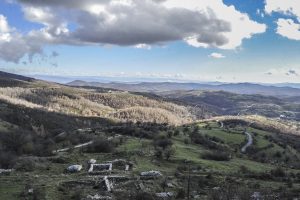
View of Novo Brdo from the fortress. | Photo: Atdhe Mulla
Young & old buck up to preserve cultural heritage
Novo Brdo is a Serb-majority municipality as outlined in the Ahtisaari Plan’s plan for liberal multiculturalism vis-à-vis decentralization, though according to the most recent figures from ECMI, a research institute that monitors minority rights, Albanian residents currently have a slight numerical majority.
Most people know the village for its 14th century fortress, and the town is trying to develop a “rural tourism” industry here, as Novo Brdo hasn’t been a mining giant since the late Middle Ages.
The main road, lined with a few houses, a small market, and a bakery, winds uphill to a small carpark for tourists. A restaurant, a mosque missing its minaret, and a few beekeepers’ homes sit at the foot of the walking path leading towards the stone structure.
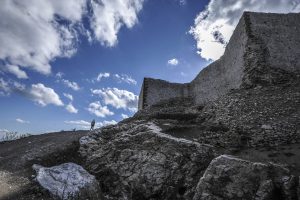
The 14th century fortress is currently undergoing EU-funded revitalizations. | Photo: Atdhe Mulla
One of the most prominent sources of work in town is the EU funded, Kosovo Ministry of Culture-led project for revitalization of the fortress. As we started climbing the path, we were lucky enough to bump into some men whose job is to watch over the premises, and who let us inside even though the workers had already left for the winter. Islam Vllasaliu, a guardian from the Ministry of Culture, Youth, and Sport, is tasked with overseeing the project.
“They’ve been working on the reconstructions on the upper half for the past two years now, but we don’t have a planned date for completion,” he said as we entered the padlock-chained doors.
In 2014, UNESCO launched a competition in partnership with the EU to offer funding for the revitalization project. The Dubrovnik-based Company Core won the bid and contracted the project to a consortium of three companies, led by Belgrade’s Koto company and accompanied by Izolimi Prishtina and Izol-Promet from Gracanica.
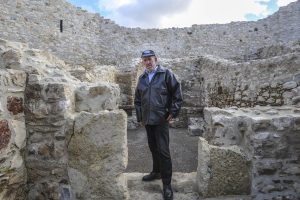
Islam Vllasaliu, guardian of the Novo Brdo fortress. | Photo: Atdhe Mulla
The Ministry of Culture approved the use of five per cent white cement for a quicker completion of the revitalization, which has raised alarm at Kosovo’s office for Cultural Heritage Without Borders.
“When they promote traditional things from the 14th century, they have to use the same original techniques. Cement will harm the stone after a while. The company [Koto] is interested in profit, and they want things to be done as soon as possible, but it is the Ministry that should be held responsible,” explained Sali Shoshi, the head of CHwB.
Avdi Bunjaku, 18, is a security guard for Koto. He’s been working as a guard since he was 16. Though he said shyly that he has to go to Prishtina or Gjilan if he wants a fun night out, he loves Novo Brdo and plans to stay around. He doesn’t see himself living anywhere but here, he said: he likes his work, he is close with his family, and Novo Brdo is home.
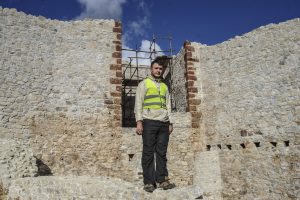
Avdi Bunjaku, 18, has worked as a security guard for the fortress since he was 16. | Photo: Atdhe Mulla
As a West Virginian with family in one of the most rural counties in the US, I understand the grip that a quiet, mountainous hometown can have on someone, despite the lack of a strong economy or social life. Novo Brdo is an ancient town with much potential for historical and archeological study. For young people in eastern Kosovo, the government’s capitalization on cultural heritage could provide opportunities to stay and make a livelihood. But such efforts could be in vain if donors and government officials do not hold historical integrity to the highest standards.
On our way back down the hill, Vllasaliu offered to let us peek inside the mosque missing its minaret.
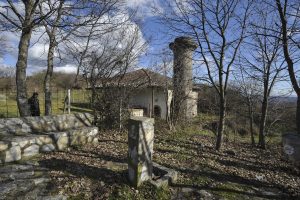
The old mosque may have lost its minaret during the Balkans Wars of 1912-1913. | Photo: Atdhe Mulla
“The mosque is about 230 years old. The minaret may have been destroyed in the Balkan Wars of 1912-13, but that could just be hearsay. It was operational up until 2005, but when its imam left town, services stopped being held. The roof has some leakage issues, as you can see,” he said.
He told me that the municipality has not yet made efforts to revitalize the mosque, which is a shame, as the ornate woodwork on the ceiling is gorgeous. I asked if the narrow staircase case leading up to the indoor women’s balcony was stable enough for me to climb.
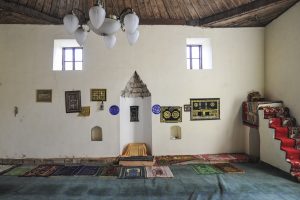
The mosque, approximately 230 years old, is not currently used for prayer services. | Photo: Atdhe Mulla
“Sure, go up and have a look… as long as an empty casket wouldn’t frighten you,” Vllasaliu laughed. A wooden casket specked with dirt was in fact stored up there.
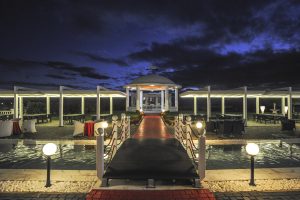
The Vali Ranch patio overlooking the village of Perlepnica. | Photo: Atdhe Mulla
Population in flux
Kamenica, a municipality in the Gjilan district, has a quaint small-town vibe, views of rolling hills in the distance, and crisp air. Since the Peace Corps, the US government international volunteer program started by John F. Kennedy, opened its office in Kosovo in 2014, Kamenica has also become the entry point for dozens of Americans coming to teach English for one to two years. Each summer, 30 to 40 Americans move in with host families in Kamenica and receive three months of intensive Albanian language lessons.
The town is basically one long two-way street lined with a post office, a few cafes, a school, and small shops. Peace Corps volunteers I’ve met in the past always reminisced about their time spent with beloved host families in Kamenica. Though the town’s pace is slow, I was told that the Sun is the hottest place around. It’s a popular bar and café, one of the only that throws parties with DJs on the weekends and that is popular with high school students during the week for studying and hanging out.
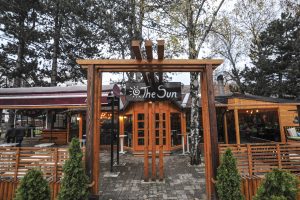
The Sun Bar, a Kamenica local favorite. | Photo: Atdhe Mulla
Sami Bunjaku, a 32-year-old actor who studied in Prishtina, owns the place. He travels back forth between Kamenica and Prishtina every week to manage the Sun Bar and his business in the capital. Despite Prishtina having more to offer an actor and theater-lover, Bunjaku plans to stay settled in Kamenica.
“I haven’t moved to Prishtina because I don’t want to give up on my small town life. It’s a quiet place, we spend our weekends riding fourwheelers in the mountains. Prishtina is more of a workplace. Life in Kamenica is green, quiet, and at ease,” he said. Bunjaku said that most graduates don’t stick around though, typical of the rural-to-capital brain-drain around Kosovo and the world.
But in summers, he said, Kamenica becomes alive with the diaspora returning on vacation and the Americans in town. “We drink all night and party until dawn in the summer months,” he grinned. “No one calls the police when we have these parties. There’s a mutual relationship of trust between neighbors and business owners here. People respect each other.”
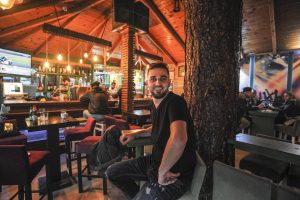
Sami Bunjaku, 32, in his Kamenica Bar The Sun. | Photo: Atdhe Mulla
He showed me a photo of the Sun Bar’s large outdoor patio from July. It was absolutely packed with people enjoying drinks under a night sky that I imagined to be impeccably lit with stars. A rural, starry skyline just can’t compete with city lights.
The winter’s early dusk began to fall as we hit the road for Gjilan. Small wooden establishments with blinking signs promising “Live Music” began to pop up along the street. Genc and Atdhe, the photographer accompanying us, filled me in on what happens behind the doors of a Muzikë Kafe. They said it’s a place where men go, perhaps after a day of work at the Bondsteel military base, to purchase overpriced drinks and watch women “belly dance.”
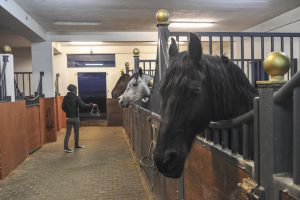
Vali Ranch has 10 horses and three ponies, which can be ridden inside a fenced-in area or occasionally for hilly treks. | Photo: Atdhe Mulla
We decided to make a pit stop at Vali Ranch, which, in contrast to the “music cafes,” is one of the most popular places in the eastern region for family outings. A restaurant and resort built by diaspora dollars, Vali Ranch offers a wedding venue, mini golf, horse riding, and even a small petting zoo with llamas.
The place looked like a nice spot for an outing with kids, though the neoclassical style made me feel as though I was in the middle of Skopje 2014 rather than rural Kosovo.
The lush, expansive grounds sitting atop a hill overlook the village of Perlepnica below.
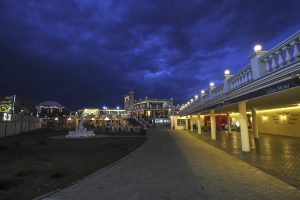
Vali Ranch. | Photo: Atdhe Mulla
The village used to be very poor, Genc told me, but many of the residents now work at Vali Ranch, which has brought some money into the area. Still, standing on the grandiose patio built looking down over a humble village, I couldn’t help but think of how much this place symbolizes the neoliberal transitions Kosovo has been going through in recent years.
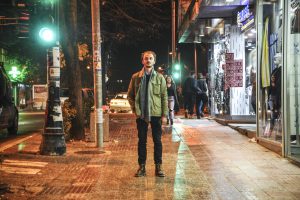
Genc Buca, 26, an architect in Gjilan. | Photo: Atdhe Mulla
Families make their own way in a transitioning economy
We arrived to Gjilan as night was beginning to fall, a city glowing with tons of green pharmacy signs and dimly lit café windows. Streets were buzzing with young people pouring into bars to have beers or endless mugs of tea.
“By 5:30 on a Friday evening, the bars are full. But the bars are full every night of the week. People have a lot of free time here,” said Genc Buca, a 26-year-old architect we met up with at Soho Café.
Buca works at the Gjilan-based Regional Office for Cultural Heritage, administered under the Ministry of Culture, Youth and Sport. He studied architecture in Tetovo, Macedonia, and then spent two years working for an architecture firm in Prishtina. He decided to return to Gjilan to be with his family and to help maintain their business, Villa Lura, a secluded but popular restaurant situated on the road between Novo Brdo and Gjilan.
Despite the overwhelming decline of factory work, families have worked to adapt to the gaps left by a struggling state and economy.
His family operated a restaurant in Gjilan since 1999, but they faced problems with the property when public land underwent privatization. This led them to relocate and purchase some land in the outskirts of the city in 2012. We stopped at Villa Lura earlier on the day while passing through. I had the best warm pogaqa me gjize I’ve ever tasted.
“We were the first in the village to open, back in 2012. We thought, why not go open something where the land is cheap? People told us that we were crazy—who would go all the way out there? But now little restaurants and villas are opening up everywhere out there, some built with money from the diaspora. It’s [getting] trendy to go into nature and take photos of your weekend trips to these villas,” Buca said cheekily.
The Buca family’s decision to step outside of the box reminded me of Genc’s family bookshop, which though was never meant to be the family’s sole source of income, has gotten them through the past two decades. Despite the overwhelming decline of factory work, families have worked to adapt to the gaps left by a struggling state and economy.
Though while talking to people from Gjilan and Ferizaj, I was repeatedly told that the impacts of war were less destructive here. This could be one reason that people have been able to get back on their feet after the mass expulsion of state workers, the decade-long Milosevic regime, and the war. People also told me that the absence of large scale devastation in the east has led to a less tense, more cooperative environment between ethnic groups (at least on the surface; the east would have most likely been more devastated by war, Genc mused, if it hadn’t ended when it did).
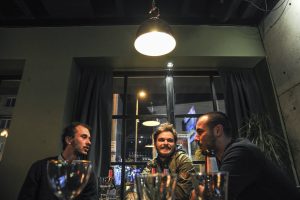
Genc Buca, Tanju Serif, and Genc Mehmeti share drinks at Soho Cafe in Gjilan. | Photo: Atdhe Mulla
We were later joined at Soho by Tanju Serif, a 20-year-old computer engineering student and indie folk musician. He studies in Prishtina, but comes home every weekend to see his family and friends, and to spend some quiet time writing.
Serif’s family is Turkish, and he said that generally, the Turkish minority is treated well in the east, at least in public. He mentioned Gjilan’s summer multicultural festival, and the region’s pride in minority cooperation. “But there are small aspects of discrimination,” he said, such as when people purposely spell Serif with the Albanian “Sh” rather than the Turkish “Ş,” even though the Kosovo law on languages states that names have the right to be spelled with original characters. (As a side, I want to point out that BIRN’s style guide instructs writers to use only English characters for names and locations).
I asked Serif and Buca about Vali Ranch and got some giggles in response. “If we try to mimic this old architecture, it can come out looking gaudy,” Buca said. But he admitted that it’s a fun place for families. Family life is what keeps him in Gjilan, and he sees closeness as the most important aspect of the Gjilani—and Kosovar—way of life.
“We don’t have a cinema. We have a theater, but it doesn’t function well. We don’t even have a proper city square. We’ve seen the outside world, though we can’t access it,” he said, referring to Kosovo’s place amongst the most isolated citizenship regimes in the world for freedom of movement. “We know that we don’t have an Eiffel Tower, but we do have our way of life.”
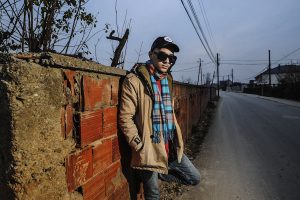
Buta, 21, outside of one of his studios in Ferizaj. | Photo: Atdhe Mulla
Fast food and American swag
Interested to see Ferizaj through the eyes of the local hip hop scene, I scheduled a meet up with local trap music star Betim Januzi, who has has gone by his stage name “Buta” since he was a child. Trap, a subgenre of hip hop coming out of the US South, known for heavy bass and lyrical themes of urban poverty, drug deals, and life on the street. After hearing word of the scene in Ferizaj, a city I knew little about, I knew I had to make a visit.
I had only previously been to Ferizaj during bus transfers from Prishtina to Camp Bondsteel, the American military base under KFOR command, situated just outside the city off of Beau Biden Highway, recently named after US Vice President Joe Biden’s son, who served as a legal advisor for the OSCE after the Kosovo War.
Bondsteel is insular, of course, steeped in protocol and security measures. But inside the gates, it operates as its own little village, complete with cabin barracks, a great gym, a rec room with games and a library, and makeshift movie theater. Unlike Prishtina, which recently got its first KFC joint, Bondsteel comes equipped with its own Taco Bell, Burger King, and market filled with American potato chips, candies, and sodas.
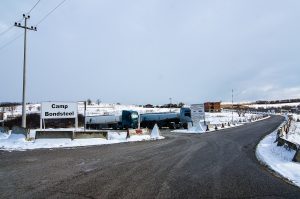
Camp Bondsteel. Photo: Valerie Plesch
A couple of years ago, I became friends with a few American soldiers stationed at KFOR and would make the occasional Sunday trip to Bondsteel consume copious amounts of junk food. We met in Prishtina, where they’d come to hang out any chance they could get. Outside of their work, American soldiers at Bondsteel need a good reason to get off base—a religious event, cultural activity, Prishtina vs. Ferizaj basketball games. Somehow they made it work pretty often. Under General Order Number One, however, drinking is strictly prohibited for American soldiers in Kosovo. Bondsteel itself is a dry base, aside from the occasional special event (like the American Super Bowl) where two beers per person are served.
Since its construction in 1999, the base has shaped Ferizaj. Thousands of residents from the region have worked there, and many went on to work with US contractors in Afghanistan, Iraq, and West Africa. The jobs pay well and have brought wealth into the city, but along with it, the stress of working in foreign conflict zones on Ferizaj families.
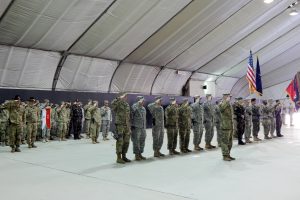
KFOR soldiers at a November 2016 transfer of authority ceremony. | Photo: Faith Bailey
We arrived in Ferizaj on a smoggy November day; the morning skies were particularly dark and gray. The road through Rrafshi i Kosoves, flat plains surrounding Ferizaj, abounds in new and used car dealers, heaps of rusty construction materials and washing machines for sale, and a peculiar number of lighting stores.
Ferizaj itself is tiny and charming, in a gritty kind of way. Historically a township, development in the city boomed in the 1970s around the construction of the Mitrovica-Skopje Railway. A courtyard shared by the town mosque, built in 1891, and the Church of the Holy Emperor Uros, built in 1933 in dedication to the Serbian emperor Uros V (hence the Serbian name for Ferizaj being Urosevac), is a focal point for foreign visitors.
The central pedestrian street, Sheshi i Qytetit, bustles with smoky cafes. In one of these coffeehouses by day, cocktail bars by night, we met up with Buta. It wasn’t his suggestion—he avoids downtown, mostly spending his time driving around with his crew and making music in his two Ferizaj studios.
The only music we could relate to was hip hop. Buta
Buta is a college student at University of New York in Tirana and only comes home to Ferizaj for occasional visits, recording sessions, and shows. He had a difficult childhood here. His mom raised him and his brother as a single mother working two jobs. His brother got caught up in a street feud in his neighborhood and spent some time in jail. He turned to music to cope.
“The only music we could relate to was hip hop,” he said. When he moved to Tirana, it was the first time he felt relaxed. But he sees his city as central to his music. “If I wasn’t born here, I wouldn’t be rapping.”
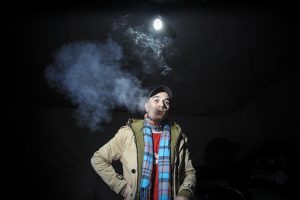
Buta. | Photo: Atdhe Mulla
He’s is a breakout star who has collaborated with Guri Mvrtini–a fashion, music, and events manager from the Swiss Albanian diaspora–and who just had his first concert in Prishtina in November.
Though he’s the most well-known rapper around these parts, there are several other lesser-known artists experimenting with trap in Ferizaj. He said that it’s the style in Ferizaj, distinctive from the rest of the country.
“In Prishtina, the way I see it, it’s basically like ‘Who’s the better rapper? Who can connect this with that? Who can use more syllables?’ But here, if you don’t have fly shit in your song, if you have no fly talk, nobody will fuck with you in Ferizaj.”
I asked him what about Ferizaj makes it distinctive.
“Well I think what’s unique about Ferizaj is that we weren’t as involved in the war. There were no bombings in the city. Here you can see a generational gap—people who do and don’t remember the war. People born ’95 and up—like me—we are different. We don’t reference it. I think that plays a major part in shaping Ferizaj’s youth. Also, the Bondsteel camp. The whole American thing. I don’t know, you have to ask an anthropologist.”





